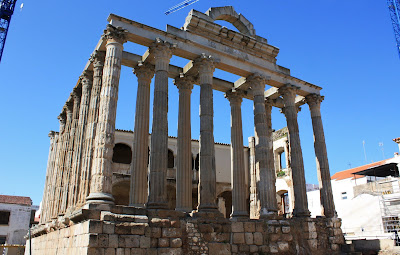If Granada is Spain’s best testimony to its Arab age, then Mérida would be the best testimony to its Roman age.
Above: Stage façade of the Roman Theatre in Mérida
This little ‘Roman City’ is the capital of the autonomous community of Extremadura in Spain and a UNESCO World Heritage Site thanks to the amazing Romanic archaeological monuments that still exist there today. From theatres to forums, bridges to aqueducts, Mérida continues to evoke the former glory & grandiose of the former Roman colony even in its current semi ruined state.
Noted for its strategic location and fertile lands, Mérida was founded in 25 BC and established as a retirement site to reward the most honorable soldiers of Roman Emperor Augustus. It was clear that the Roman inhabitants wanted to make this spot in the Iberian Peninsula a ‘home away from home’.



Above: The National Museum of Roman Art. It showcases a great variety of exhibits that will take you through the history of the Roman era in Mérida.
A short distance away from the Museum is the site of the 2 most visited attractions - The Roman Theatre and The Roman Amphitheatre.

The Roman Theatre is a classic example of the splendor of Roman architecture. The grand stage features two tiers of Corinthian columns adorned with sculptures of divinities. It faces a semi-circular, tiered seating theatre with a 6,000 seating capacity.
What's amazing is that it still serves its function up til today, being the venue of the Festival of Classical Theatre since 1933.

*Click on photo for larger view


*Click on photo for larger view


*Click on photo for larger view
Above: The Roman Amphitheatre. Constructed in the year 8 BC, it could seat up to 15,000 spectators for events such as gladiator combats or wild animal battles.
As you wander around the city, inevitably you'll notice the remnants of the Roman empire everywhere. Columns and archs that are the unmistakeable characteristics of Roman architecture.

Above: ‘Templo de Diana’ (Temple of Diana) built in 'Corinthian order' style slender columns.

Above: 'Pórtico del Foro' (Portico of the Forum)

Above & below: Plaza de España





Above: The Good Friday procession.

Above: ‘Arco de Trajano’ (Arch of Trajan). It is believed that this is the gateway to a series of sacred temples devoted to the imperial cult.
Further away from the city center, there are lots of other sites to be explored.
Further away from the city center, there are lots of other sites to be explored.
One of the few remaining traces of the Arab rule in Mérida is the Alcazaba, built by the Arabs in the 9th Century as a fortress to safeguard the passage through the Guadiana River.

Above: Exterior of the Alcazaba.

Above & below: Walls of the Alcazaba.


Above: The Lusitania Bridge over the Guadiana River (as seen from the Alcazaba).

Above: The Roman Bridge over the Guadiana River. Stretching almost 800 meters long, it was considered one of the longest & most important in the Roman Empire.

Above: Outside the Alcazaba stands the statue of the Capitoline She-Wolf suckling two human babies, a traditional icon of ancient Rome. Another similar one can be found in front of the aqueduct in Segovia.


Above: Outside the Alcazaba stands the statue of the Capitoline She-Wolf suckling two human babies, a traditional icon of ancient Rome. Another similar one can be found in front of the aqueduct in Segovia.

Above: What’s left of the ‘Circo Romano’ (Roman Circus). Built in the 1st Century AD, it was used for chariot races and other sporting events. It could seat up to 30,000 spectators, making it the largest public entertainment venue.

Above: The Aqueduct of San Lázaro



Above: The ‘Aqueduct of Miracles’ (Acueducto de los Milagros).
This astounding feat of engineering has now become an astounding piece of art standing on the outskirts of Mérida. The sight of it just took my breath away! I love the linear shadows cast by the setting sun…it's so beautiful!

Above: The tiny Alberragas River that flows through under the aqueduct.This astounding feat of engineering has now become an astounding piece of art standing on the outskirts of Mérida. The sight of it just took my breath away! I love the linear shadows cast by the setting sun…it's so beautiful!

Love how the 'm' shaped shadow of the aqueduct can be seen on the grass here.
Still much more to come on Extremadura!








No comments:
Post a Comment